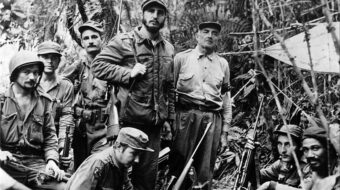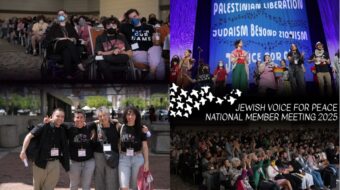
Starting with the election of Hugo Chávez as president of Venezuela in 1998, Latin America saw a wave of elections of left-wing and left-center governments. In addition to Venezuela, this “Bolivarian pink tide” eventually brought progressive governments of various stripes to power in Argentina, Bolivia, Chile, Ecuador, Guyana, Honduras, Nicaragua, Paraguay, and Uruguay, as well as some small island countries.
Joining with socialist Cuba, Chávez’s Venezuela – the most left-wing of the pink tide governments – moved to create the Bolivarian Alliance for the Peoples of Our America, or ALBA, in 2004. ALBA today includes eleven states large and small, including Venezuela, Cuba, Ecuador, Bolivia, and Nicaragua.
Beyond ALBA, there are several multinational cooperation mechanisms: UNASUR (Union of South American Nations), MERCOSUR (South American Common Market), and finally CELAC (Community of Latin American and Caribbean States), which includes all the independent countries of the Western Hemisphere, except the United States and Canada. It includes countries with right-wing as well as left-wing governments.
The Bolivarian vision
This Bolivarian movement has pursued a series of interlocking goals over the past several years.
First, it has aimed at increasing the “horizontal” dynamic of trade and mutual support among the countries of South and Central America and the Caribbean states, thus reducing their “vertical” dependence on the United States.
Secondly, it has sought a re-set of trade relations among the countries of the region. An attempt has been made to move away from the neoliberal pattern of domination by transnational monopolies and wealthy states which impose conditions such as austerity and privatization. In its place, efforts have been centered on establishing new trade relations within and beyond the region that are explicitly aimed at benefitting the mass of the people – improving both their rights and their living standards.
Increasing the level of mutual support among the nations involved so as to provide help of various kinds to the poorest among them has been a third goal. Examples of such support have included discounted Venezuelan oil supplied through the PETROCARIBE organization, health care assistance from Cuba, and many other mechanisms of solidarity to combat regional inequality.
In the longer term, there is a plan to eventually launch a new regional trading currency, the SUCRE, so as to end the domination of the U.S. dollar in trade relations.
And finally, the vision is to pursue all these goals via systems of sustainable and environmentally friendly production, while combatting historic patterns of racial, ethnic, and gender inequality and other forms of social injustice.
In the 19 years since the election of Chávez in Venezuela, many of the countries participating in the Bolivarian project have made great strides toward meeting those goals, especially those that relate to the well-being of their poorest citizens. ALBA and the Bolivarian movement was also successful in blocking George W. Bush’s neoliberal “Free Trade Area of the Americas”.
A receding pink tide?
However, since the onset of the world financial crisis that began with the U.S. mortgage disaster in 2007-08, the Bolivarian “pink tide” has run into strong headwinds. The fall in commodities prices has greatly stressed several of the countries including, crucially for ALBA, Venezuela. Left-leaning governments were removed by a military coup in Honduras in 2009 and by constitutional coups in Paraguay in 2012 and Brazil in 2016. And center-left forces were ousted in the Argentine elections in December 2015.
It goes without saying that transnational monopoly capital and the governments of the United States and other wealthy capitalist countries have not lost an opportunity to exert maximum disruptive pressure against the left-wing governments, with Venezuela currently being the target of an imperial “full court press.” The new right-wing governments of the region have made it clear that they intend to turn back the clock and return to the neoliberal, so-called “free trade” approach to international commerce.
But the Latin American left is not giving up. Rather, it is moving to create and reinforce mechanisms of unity between leftists in power and people’s grassroots organizations which share the same goals. That way, even if there are more reverses at the level of the national government, the leftward movement can continue in every country, fueled by grassroots organizing and people’s struggle.
At a meeting of the Political Council of ALBA in Havana on Monday April 10, Cuban Foreign Minister Bruno Rodríguez Parrilla gave voice to the views of many on the Latin American left: “The Havana meeting should serve to continue reinforcing unity and [our] ability to work together, as well as reinforcing the process of Latin American integration.”
Rodríguez Padilla strongly emphasized the need for all progressives to support the embattled government of Venezuela against efforts by the United States and the right-wing Secretary General of the Organization of American States, Luis Almagro, to destabilize that country.
Uniting at the São Paulo Forum
Besides ALBA and the other entities created by the Bolivarian pink tide, the older São Paulo Forum is seen by the Latin American left as still playing a vital role in maintaining and expanding popular struggles against neoliberal imperialism throughout the region.
The São Paulo Forum was created in 1990, well before the election of Chávez, so is older than the specifically Bolivarian institutions such as ALBA. It includes political parties of a left and left-center type in most of the countries of Latin America and several in the Caribbean as well, including Puerto Rico.
The Forum is intended to be broadly inclusive, with communist, social democratic, and other parties working together within its structure. In turn, these left-wing parties have a very large presence in social movements (unions, farmers’ organizations, youth, women’s, and environmental groups etc.) throughout the hemisphere.
With the current crisis of the left in Latin America, many left-wing leaders now see the São Paulo Forum taking on increased importance.
This year, the annual general meeting of the São Paulo Forum will take place in Managua, Nicaragua from July 16 to 18.
The Working Group (executive committee) of the Forum met in Managua on January 11 and 12 and among other things, approved a guiding document for the organization’s work, called the Consensus of Our America (Consenso de Nuestra América).
Though only 24 pages long, it covers a wide range of topics. It starts out with a Marxist analysis of the state of the world capitalist crisis and its impact on the Latin American region, establishes general political and ethical principles to guide the work of the Latin American and Caribbean left, and puts forth a program of political action for the future. The document gives ample coverage to issues of global warming and women’s, minorities, and LGBTQ rights as well.
The authors of the “Consensus” do not see the current capitalist crisis as a routine cyclical crisis of overproduction, but as something much greater and more threatening to the future of capitalism.
Further, they point out that the restored neoliberal governments in Argentina, Brazil, and some other countries will not be able to meet the demands of workers and other mass sectors. Indeed, massive protests by workers and others against right-wing governments – from Mexico and Brazil to Argentina and Paraguay – illustrate the fact that the working people of the hemisphere are not giving up the struggle.











